
Tower of London
[ < < previous | index | next >> ]
We've moved hotels and are now enjoying a large, modern, and blissfully quiet room here at the Premier Inn. Not only is it better in every respect than our previous lodging, but it has a "good night's sleep or your money back" guarantee, which will be put to a serious test tonight.
We arrived here with our luggage after checking out of the Jenkins Hotel this morning. Our luggage had to be left in the luggage room until we could check in this afternoon. That done, we headed to the nearest bus stop to hop on a bus south to Aldwych and change there for a route 15 bus to the Tower of London. This bus passed right by St Paul's Cathedral, giving us our first glimpse of the monumental structure.
But our goal was further on. We left the bus on Tower Hill and used the tunnel access under the street to approach the Tower itself. The structure was more sprawling than I expected, being essentially a complete concentric castle, not merely a "tower".
 Tower of London |
We joined the queues of people waiting to buy tickets, which at £17 each were the most expensive attraction tickets so far. We hoped it would be worth it! There was also a queue to get in, where tickets were docked and bags were searched, though there were no metal detectors like at Lord's. Unfortunately we had just missed the 11:30 guided tour and the next tour began at 12:15. So we wandered around a little bit ourselves, staggered at the sheer geographic sprawl of where we found ourselves.
After a brief toilet stop, we soon found ourselves face to face with the Tower's famous ravens. Enormous black birds, these hopped around the lawn inside the inner wall, threatening anyone who looked like they had food with them. They seemed quite fearless, coming right up to people. Signs warned that they could deliver nasty bites.
 Raven, Tower of London |
From here we could see the oldest part of the Tower, the central White Tower, which was built by William the Conqueror around 1080 to impress his new rule on the people of London an England. South of this was built the medieval palace overlooking the Thames, where several medieval era kings and queens lived, and which now forms part of the outer wall of the complex. We didn't look around too much because we wanted to get our bearings from the guided tour first. So instead we perused the rather large gift shop, which had a wide selection of more or less gory souvenirs and informative items. One item was a constructible paper model of a beheading - with the option to build it with the prisoner intact or severed.
 White Tower, Tower of London |
With 10 minutes to go, we returned to the waiting area for the tour. A large group of possibly up to 150 or so people were clustered around the meeting point and the Yeoman Warder (commonly referred to by the nickname "Beefeater") who soon arrived thankfully had a loud voice with which to reach everyone. He began a patter of informative history of the Tower, mixed with some well-worn comedy. It was very entertaining and definitely worth it for the historical facts as well. He led the group through a range of locations in the Tower complex, stopping to give a 10 minute or so speech in each spot. First we listened to an introduction at the meeting point near Middle Gate - so named, we learned, because it was in the middle of the (now dry) moat.
 Yeoman Warder, Tower of London |
The next stop was just inside the outer wall, and then followed a stop at the Traitor's Gate, through which prisoners accused of treason arrived at the Tower. The gate had a portcullis dropped down into water, which was originally connected to the Thames so that the traitors could be brought in under the gate by boat and unlocked inside the Tower wall.
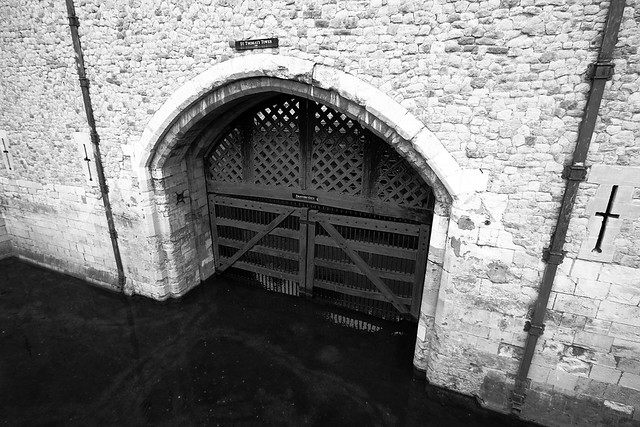 Traitors' Gate, Tower of London |
Next was a stop inside the inner wall, where the history of the Norman-era White Tower was explained. There was one more stop near the green where executions of prisoners took place - including Anne Boleyn - with a gory account of how the deed used to be done. The final stop was within the chapel, where many of the victims from the Tower were laid to rest. Queen Victoria had the chapel (which had fallen into disrepair) refurbished, and the workers found the remains of hundreds of bodies under the floor. Only nine were identified and Victoria ordered all the others to be removed and given Christian burials.
 Guided tour, Tower of London |
The guide's speech in the chapel was interrupted by a woman's phone ringing - despite his dire warnings outside to everyone to switch their phones off because they'd die of embarrassment if they rang. He walked up to the woman and demanded the phone, then tried to answer it, but unfortunately the caller wasn't there by that time. It would have been amusing to hear what he would have said if he got talking to the caller!
With the chapel done, the tour ended and the group gave our guide a rousing applause for a job well done. By this time it was 13:15 and we were getting hungry, so we exited the Tower and got lunch at a nearby French cafe stand. M. got a quiche with leeks in it and I got a very crusty bread roll with prosciutto and salad on it, which was excellent. We also stopped to take a few photos here by the bank of the Thames of the nearby Tower Bridge and the activity along the river and shore.
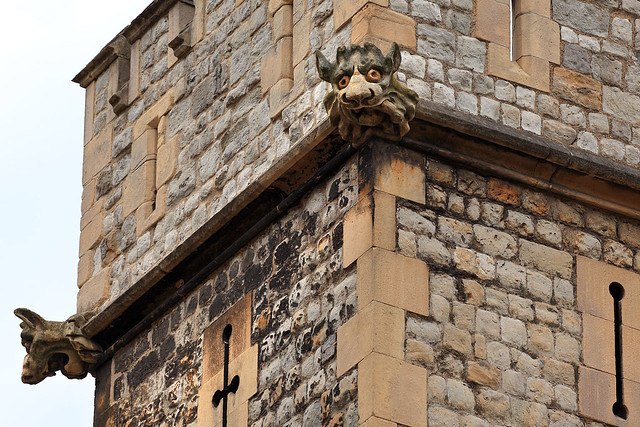 Gargoyles, Tower of London |
We returned to the Tower and headed straight for the star attraction: The Crown Jewels. They were housed in a building on the north side of the inner wall. There were long queuing corrals which led past three different video presentations about the jewels and the coronation traditions, but there were few enough visitors today that we didn't need to wait at any of them. We chose to wait at the first two to see whct the short videos had to say. By the time we got to the third one, we simply walked through, eager to see the jewels.
We passed into a large vault, through ultra-modern ultra-thick bank-vault-style doors. First up was the golden coronation spoon and an ampoule in the shape of a bird, both made of gold and very shiny. The ampoule contains holy oil which is tipped out of the beak (cow milk-jug style) into the spoon, and then anointed onto the head of the new monarch. We saw the coronation robes, woven with gold thread and patterned in an intricate design with large red and white roses, thistles, and shamrocks interspersed with a creature that may have been a dragon or a griffon. It was sparkly and stunning. But the major attractions were the dazzling jewelled crowns, orbs, and sceptres. These were on display in gleaming glass cabinets past which two moving walkways - one on each side - dragged observers at an unsatisfactorily rapid pace, presumably in order to prevent people from stopping, gawking, and preventing anyone else from getting a look. Once past these there was the opportunity to stop for a longer, but more distant, look on a raised walkway behind one of the moving ones.
 Tower of London with view of Thames and Tower Bridge |
These jewels included the coronation crown, worn only for coronation ceremonies, and the sceptre incorporating the Star of Africa diamond - the largest cut diamond in the world. The second largest is also present here, in the Queen Mother's crown. There were other dazzling items: crowns, sceptres, orbs, swords, and so forth. Then after the jewelled items came sets of golden objects: cups and plates and table settings. There was a giant golden punch bowl large enough to have a bath in, ornately carved with figures of plants and animals, accompanied by a scoop, shaped like a nautilus shell, large enough to fill several glasses. The final item was the Imperial Crown of India, made for George V on a visit to India. Since the other crown jewels aren't allowed to leave England, a special crown was made to use in India. George wore it once and it hasn't been used since because India is now independent.
Exiting the jewel vault, we moved to the White Tower, which held a special exhibit on Henry VIII. Known mostly for being fat and killing various wives as he got bored with them, it turned out old Henry was actually quite the athletic type in his youth and tried his best to keep it up in his later years, despite the weight gain. The exhibit included a host of suits of armour designed for and used by Henry. In his younger days he apparently cut a dashing and muscular figure, as evidenced by some rather svelte suits of armour, in which he fought tournament battles, both on foot and on horseback. There was also jousting armour - Henry was very good at jousting.
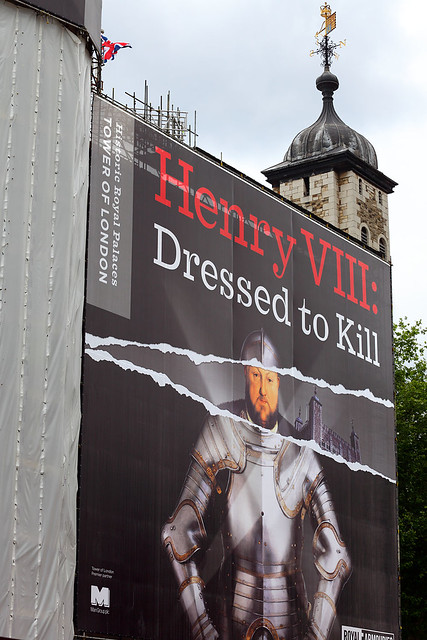 Exterior of the Henry VIII exhibition, Tower of London |
There was proper battle armour too. Henry led armies into the field on multiple occasions - he didn't win much in his battles against France, but at least he was up there and trying. Even though he gained weight in later years, he continued fighting in tournaments and various new suits of armour were made for him. By measuring these suits, we have excellent evidence for Henry's measurements throughout his life. He was also enamoured with weapons of all types, especially the newly developing gun technology. He commissioned and used several new types of gun, with several being attached to or concealed in more traditional weapons and even shields. It was Henry's idea to build a gun into a shield and we saw several examples. All in all, it was a very informative and illustrative display with a cornucopia of genuine Henry VIII artefacts in excellent condition. Definitely eye-opening and well worth the time we spent there.
From the White Tower we headed to the Bloody Tower - purportedly the imprisonment and murder place of the young sons of Edward IV (even more purportedly at the hands of Richard III). We saw the staircase under which the skeletons of two boys were found - possibly those of the young princes. There was also the room in which Walter Raleigh was imprisoned and began writing his Historie of the World.
From here we took a walk along the south wall into the medieval palace - home of kings such as Henry I and II, and King John. Some of the rooms here in these royal apartments were decorated in medieval recreations to give an idea of what they would have been like. There was also a chapel and some magnificent medieval tiled floors. The palace led us out to the south wall, from where we got magnificent views of the Thames and Tower Bridge.
 Royal apartments, Tower of London |
Exiting the Tower after what turned into several hours of looking around the sprawling complex, we rested for a bit by the bank of the Thames, with a view of the Tower Bridge nearby. A bit exhausted, we abandoned our plans to visit St Paul's Cathedral today, since it was getting late already and we could really use a rest from all the sightseeing to regain our strength. So we hopped the buses back to the Premier Inn, collected our left luggage, and checked in.
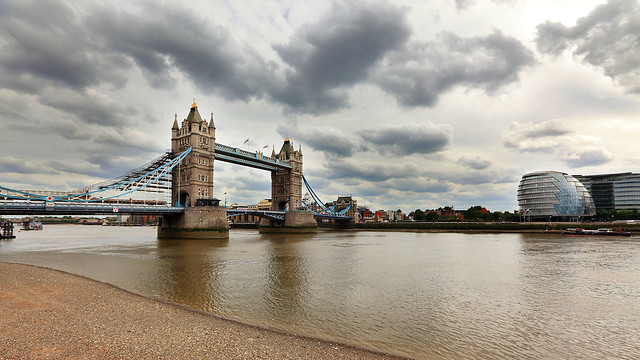 Tower Bridge |
Bliss! The room is about three times the size of our previous room, and the bathroom is about five times the size of the old bathroom. And the floors don't squeak! The view out the window is not as nice, being straight on to an adjacent building, but as it turns out it has glass brick walls which you can sort of see through and is a dance studio with four floors of performance space. We've seen people practising ballet, what looks like martial arts, and one group doing an African style music and singing rehearsal - we could hear it softly but it's nothing compared to the noises in the old hotel.
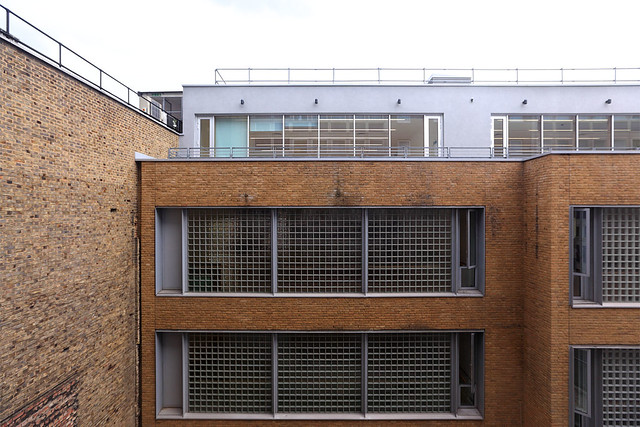 View from our room at the Premier Inn, across to the ballet studio |
Oh, but there's one more tale to tell as we left the Tower. On the way to the bus stop, I was snapping a few final photos of the Tower with my long lens. A policeman approached us and said, "Excuse me sir, can I have a word with you about your photography?" I hadn't knowingly been taking photos where I shouldn't, and in fact the officer quickly reassured me that I hadn't done anything wrong, but that he was interviewing me briefly and conducting a search under the powers of Section 44 of the Terrorism Act (since ruled illegal by the European Court of Human Rights and abolished in January, 2010). He pretty much quickly determined I wasn't a terrorist, since the search was no more than me opening my camera bag's main compartment and him having a quick peek inside. He was very polite throughout and gave me a lot of explanation of what he was doing and why, and then wrote up a "stop and search" incident report and gave me a copy. He said I could keep taking photos and thanked me for our time. All up, it took less than five minutes. And now I can tell people I was stopped and searched by a police officer on suspicion of terrorism only 150 metres from the Crown Jewels!
After resting in our hotel room for a couple of hours, M. expressed a desire to try the veg burger at Mabel's Tavern again. This time I tried their fish and chips. It was good and I noticed that, similar to the Wheat Sheaf near Bath, the batter was cooked to be dark in colour and very crispy, unlike the usual pale golden and still a little soft version at home.
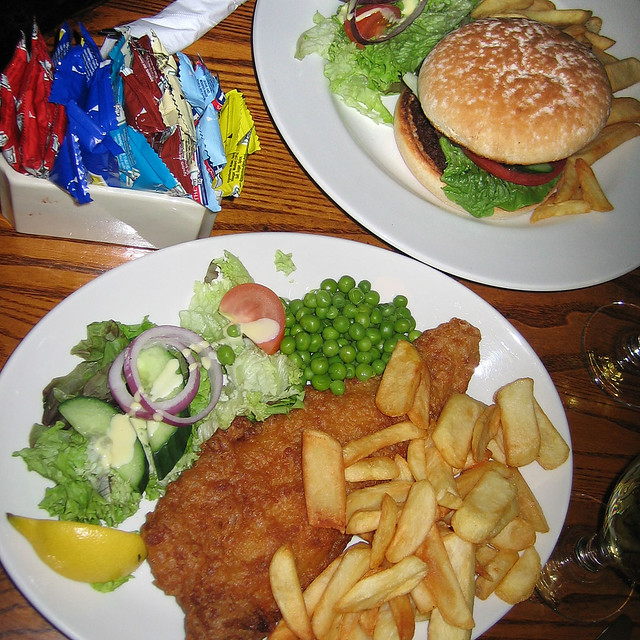 Dinner at Mabel's Tavern |
I decided that dessert wasn't needed and we returned to our room for what will hopefully be a very good night's sleep. With no hotel-supplied breakfast that we need to be up for (we opted not to pay the extra for it), we turned off our alarm, slipped the "do not disturb" sign on the outside of the door, and went to bed determined to sleep in as long as our weary bodies wanted.
[ < < previous | index | next >> ]